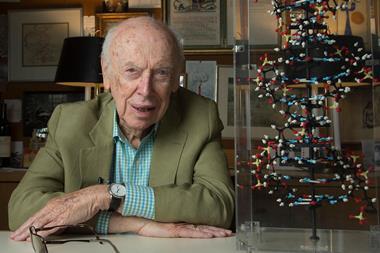Readers remember Martin Hughes and reminisce about long careers
Martin Hughes
Inorganic chemistry plays key roles in biology. Martin Hughes, who has died aged 84, made seminal contributions in enzymology, toxicity, oxygen activation proteins, metals in medicine, environmental chemistry, and biomineralisation.
Hughes’s scientific career was seeded by his father, who made important contributions to hot-dip galvanisation in the 1940s. Born in Swansea, Martin stayed there for a BSc and PhD, during which time he married Jenny Collard in 1961. His 1962 thesis was entitled Mechanisms of Nitrosation Reactions, a topic that shaped his future. Most of his career was spent at Queen Elizabeth College (QEC), a small, single-faculty, multidisciplinary constituent college in Kensington within the University of London. There, his productive collaborations with biologists, which underpinned his subsequent career, were fostered, resulting in his monograph The Inorganic Chemistry of Biological Processes, published in 1972. His first microbiological collaboration at QEC was with Don Kelly, succeeded by myself upon the departure of Kelly to a chair at Warwick. Our collaboration enabled supervision of many talented postgraduates at the chemistry-microbiology interface, many peer-reviewed papers and a book. Collaborations were disrupted, but not broken, by the merger of QEC, Chelsea College and King’s College London in 1985. Until the eventual sale of the QEC site, Hughes (who was appointed professor in 1990) made valiant efforts to travel between the King’s Strand campus and his congenial, multidisciplinary home in Kensington.
A further pointer to later achievements appeared in a highly cited paper on the decomposition of trioxodinitrate (Angeli’s salt), used as a source of the metastable nitroxyl, and hence nitric oxide, a critical signalling molecule and toxic gas in biological systems. His expertise in preparing nitric oxide and insights into the complexities of its chemistry and its congeners in solution led to numerous publications and the discovery of the link between nitric oxide and a member of the ancient globin family, namely a bacterial flavohaemoglobin, now regarded as the most important nitric oxide detoxification enzyme in microbes.
A meeting with Jack Barrett, a colleague at King’s, led to the commercial exploitation of metal-microbe interactions. Moderately thermophilic chemolithotrophic bacteria that I isolated were used to oxidise low-grade pyritic gold-bearing ores, thus destroying the pyrite lattice and rendering previously intractable ore residues amenable to gold recovery by complexation with cyanide. The technology and large-scale pilots were funded by venture capitalists in Perth, Australia, and led to an extant bio-mining and bio-leaching company, BacTech, offering environmentally friendly technology.
Hughes was a popular, sought-after and inspiring university teacher who generated enthusiasm and respect in students and a wider audience. Despite intensive workloads, he was unfailing in his patience with, and compassion for, those he worked with, especially those having difficulties in their studies or private lives. He was one of the most sympathetic and kindly men imaginable, consistent with his deep religious faith. He could see the same hand of Providence in the natural world and in the Bible, which he studied with the same rigour as his chemistry. He was as engaging in his lectures on Bible prophecy as he was in dissertations of chemistry.
Hughes is survived by his three sons, Jonathan, Richard and Simon. I am indebted to them and to Simon Collard for information and encouragement.
Robert Poole FRSC
Sheffield, UK
Calling all GRICs
I was intrigued by Frank Holland’s description of his ‘escapades through the UK chemistry system’ in the late 1950s. It mirrored mine, and he is in fact just under a month younger than I am. I too, worked in the Liverpool area, but for Bibby and Sons at their experimental farm close to Neston. I was at the Birkenhead College of Technology from 1956 part-time, taking one day a week off from work to attend, as well as evenings as necessary. I had taken my A-levels before joining Bibby’s, and like Frank I did the ONC, HNC and then a year at Birkenhead Tech mainly self-funded. Frank joined the Royal Institute of Chemistry (RIC) the year before I did, so he definitely has the bragging rights.
We may well have taken the same practical exam at the School of Pharmacy in London (four days of hell!) in June of 1960. If I can find the letter from the RIC stating that I had passed, I should be able to find him on it, as the pass rate for the Part II RIC was 28% that summer and all people who passed were listed on the one-page letter. I only know of one other 21-year-old who took the Part II externally that year. Any other 21-year-old GRIC’s by external examination known to the RSC to add to the three of us?
A few years later the RIC allowed a full-time variation at some Colleges of Technology, where the students did not have the six days of external exams.
I ended up doing a two-year MSc (by thesis) at Liverpool (which had a requirement then for a two-year sojourn before a degree could be awarded). I learned there that it was not a good idea to prove your supervisor’s major publication wrong in the first three months, especially when it was supposedly the starting point for your PhD programme. After my ARIC/MSc I spent time in the UK photochemical industry and then joined the ARC’s Unit of Nitrogen Fixation at Queen Mary College London as a research technician, having had my fill of UK industry, and ended up with a DPhil from Sussex as the Unit moved there in very late 1966. This degree in microbial chemistry was effectively external, even though there was no such formal beast, and I migrated west to the US in the days when a green card could be obtained before leaving the UK. I ended up marrying an American and stayed.
David Newman
Via email
Membership record?
Further to recent letters from readers about their long membership of the Royal Society of Chemistry, in December 2017 the RSC presented a certificate for 75 years’ membership to 97-year-old Donald Sarfas. Sarfas lived to be 100 and his RSC membership totalled 78 years. He also had the distinction of having a retirement equal in length to his working life of 42 years.
Geoff Collier CChem FRSC
Via email
Chemistry World welcomes letters, which should be concise (normally fewer than 300 words) and timely. Those selected for publication are subject to editing for clarity and length. Letters should be marked ‘for publication’ and sent to chemistryworld@rsc.org
We do not routinely acknowledge letters.












No comments yet